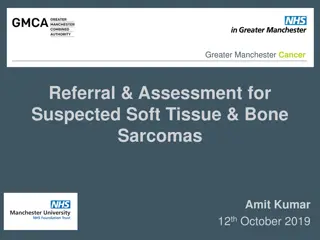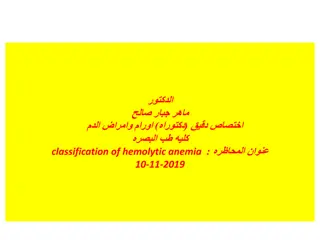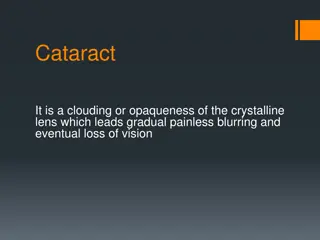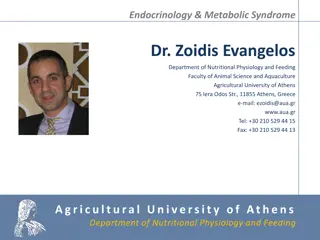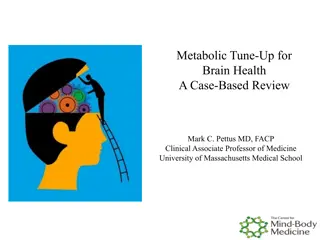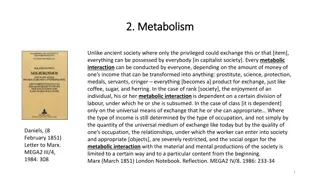Understanding Metabolic and Complicated Cataracts: Classification and Subtypes
Explore the etiological classification of cataracts, focusing on metabolic and complicated types such as diabetic cataracts, galactosemia-related cataracts, myotonic dystrophy-related cataracts, and hypocalcaemic cataracts. Learn about distinct morphological subtypes, pathophysiology, and specific characteristics of these cataracts. Enhance your knowledge to classify cataracts based on their underlying causes and biochemical abnormalities.
Download Presentation

Please find below an Image/Link to download the presentation.
The content on the website is provided AS IS for your information and personal use only. It may not be sold, licensed, or shared on other websites without obtaining consent from the author. Download presentation by click this link. If you encounter any issues during the download, it is possible that the publisher has removed the file from their server.
E N D
Presentation Transcript
Metabolic and complicated cataract Dr.Ajai Agrawal Additional Professor Department of Ophthalmology AIIMS, Rishikesh
Learning Objectives At the end of this class students shall be able to : Classify cataract according to aetiology. Understand pathophysiology of metabolic and complicated cataract. Identify distinct morphological subtypes of metabolic and complicated cataract. 2
Definition of cataract Any opacity in the lens or its capsule 4
Etiological classification of cataract 1. Age related cataract 2. Traumatic cataract 3. Metabolic cataract 4. Complicated cataract 5. Toxic cataract 6. Radiation induced cataract 5
METABOLIC CATARACTS Due to endocrine disorders and biochemical abnormalities. Diabetic cataract Hyperglycemia Excess glucose metabolizes into sorbitol (Aldose reductase mediated) Osmotic over hydration 6
1. Age related cataract in diabetics Early onset Rapid progression 2. True diabetic cataract. Also called snow flake cataract or snow-storm cataract Fluid vacuoles appear underneath anterior and posterior capsules Bilateral snowflake-like white cortical opacities Snowflake cataract 7
Galactosemia Multisystem disorder Inborn error of galactose metabolism Anterior and posterior subcapsular lamellar opacities- oil droplet cataract Oil droplet cataract 8
Myotonic dystrophy Fine dust like opacities with tiny iridescent spots in cortex- christmas tree cataract May progress to stellate opacity at posterior pole Christmas tree cataract 9
Hypocalcaemic cataract May be associated with parathyroid tetany. Multicoloured crystals or Small discrete white flecks of cortical opacities 10
Wilsons disease Sunflower cataract is rare in such patients. Kayser-Fleischer ring (KF ring) in the cornea is more common. Sunflower cataract (Photographs- Courtesy : Kanski s Clinical Ophthalmology) 11
Lowe's syndrome Lowe s (Oculo-cerebral-renal) syndrome Rare inborn error of amino acid metabolism. Ocular features congenital cataract and glaucoma Systemic features mental retardation dwarfism osteomalacia muscular hypotonia frontal prominence. 12
COMPLICATED CATARACT Opacification of the lens secondary to some other intraocular disease. Inflammatory conditions Uveal inflammations (like iridocyclitis, pars planitis, choroiditis) Hypopyon corneal ulcer Endophthalmitis. 14
Degenerative conditions Retinitis pigmentosa Myopic chorioretinal degeneration Retinal detachment Long-standing cases Glaucoma (primary or secondary) Intraocular tumours Retinoblastoma Malignant melanoma 15
COMPLICATED CATARACT Lens changes typically in front of the posterior capsule. Irregular in outline Variable in density Appearance like breadcrumb . A very characteristic sign is Iridescent coloured particles polychromatic lustre of reds, greens and blues. 16
COMPLICATED CATARACT Chronic anterior uveitis Most common cause Polychromatic lustre at posterior pole If persists, anterior and posterior opacities develop 17
Angle closure glaucoma Focal infarcts of lens epithelium -small grey-white anterior subcapsular or capsular opacities glaukomfecken 18
Pathological myopia Posterior subcapsular opacities Early onset nuclear sclerosis Hereditary fundus dystrophies Lebers: total cataract Stickler syndrome: cortical cataract 19
Toxic cataracts 1. Smoking 2. Alcohol 3. Drug induced cataract Corticosteroids Phenothiazines Pilocarpine Diuretics Amiodarone Allopurinol Chloroquine 20
Other types: Infrared (heat) cataract: Glass-blower s or Glassworker s cataract Irradiation cataract Ultraviolet radiation cataract Electric cataract 21
MANAGEMENT OF CATARACT IN ADULTS A. Non-surgical measures B. Surgical management 22
Non-surgical measures 1. Treatment of cause of cataract 2. Measures to delay progression 3. Measures to improve vision in the presence of incipient and immature cataract 23
Surgical management Indications 1. Visual improvement 2. Medical indications : Lens induced glaucoma Retinal diseases like diabetic retinopathy or retinal detachment (treatment of which is hampered by presence of lens opacities) 3. Cosmetic indications 24
Preoperative evaluation I. General medical examination of the patient II. Ocular examination A. Retinal function tests B. Search for local source of infection C. Anterior segment evaluation by slit-lamp examination D. Intraocular pressure (IOP) measurement 25
Retinal function tests Light perception (PL) Projection of rays (PR) Pupillary reaction to light Two-light discrimination test Maddox rod test 26
Retinal function tests Colour perception Entoptic visualisation Laser interferometry Objective tests for evaluating retina like VEP, ERG, EOG, USG 27
Preoperative medications and preparations 1. Topical antibiotics 2. Preparation of the eye to be operated. 3. An informed and detailed consent 4. Scrub bath and care of hair. 5. To lower IOP 6. To sustain dilated pupil Anaesthesia LA/GA 28
Types and choice of surgical techniques Phacoemulsification (MICS) Small incision cataract surgery (SICS) Extracapsular cataract extraction (ECCE) Intracapsular cataract extraction (ICCE) 29
Conclusion Metabolic cataracts are due to endocrine disorders and/or biochemical abnormalities. Complicated cataracts involve opacification of the lens secondary to some other intraocular disease. Many metabolic and complicated cataracts have distinctive morphologies. 30
Thank you 31











